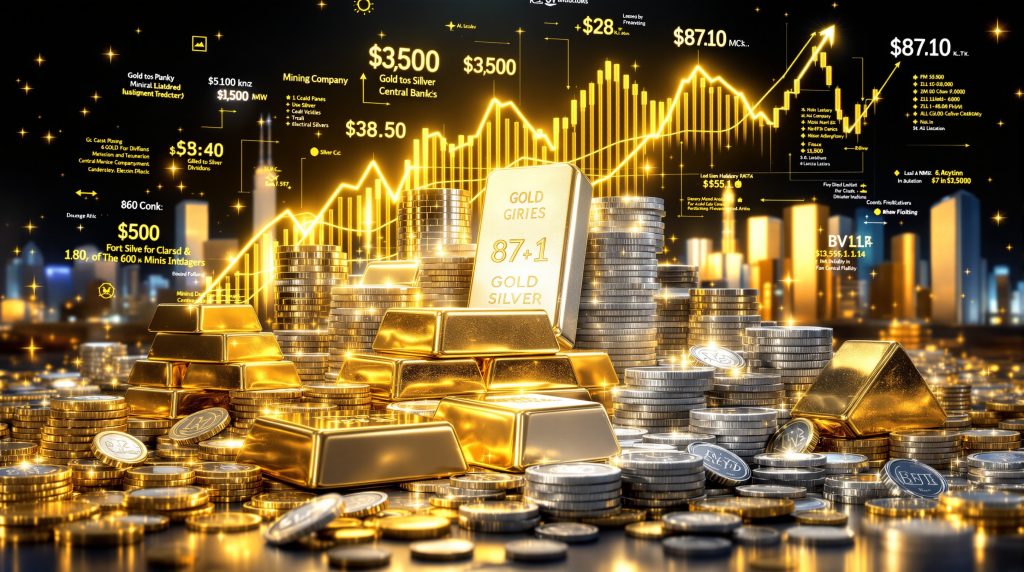How Are Gold and Silver Markets Performing in 2025?
The precious metals market is experiencing a notable transformation in 2025, with both gold and silver showing remarkable price movements. Gold has surged beyond historic levels, establishing new record gold highs analysis above $3,500 per ounce, while silver has rallied impressively to multi-year highs above $38 per ounce with strong momentum toward the psychologically significant $40 mark.
This uptrend represents a fundamental shift in market dynamics driven by a complex interplay of macroeconomic factors, evolving investor sentiment, and changing supply-demand fundamentals. The monthly close for silver reached a 14-year high, representing one of the strongest technical signals in over a decade.
For investors navigating this landscape, understanding the underlying drivers and potential future directions has become essential for making informed decisions in what appears to be an accelerating precious metals bull market.
What's Driving Gold's Record-Breaking Performance?
Macroeconomic Uncertainty and Monetary Policy
Gold's exceptional performance in 2025 stems primarily from significant monetary policy shifts and growing economic uncertainties. After maintaining higher interest rates through 2023-2024, the Federal Reserve has pivoted toward a more accommodative stance, implementing multiple rate cuts that have reduced the opportunity cost of holding non-yielding assets like gold.
This monetary easing cycle has coincided with persistent concerns about economic growth, particularly as labor market data has shown increasing weakness. Recent non-farm payroll reports have consistently underperformed expectations, with several downward revisions to previous figures suggesting the economy may be cooling more rapidly than initially anticipated.
Market analysts note that previous BLS job revisions have been consistently negative, indicating a potential structural weakness in the labor market that's only now being fully recognized in economic data. This realization is fueling gold's appeal as a safe haven asset.
Central Bank Accumulation Patterns
Central banks globally have maintained their gold purchasing programs at a more measured pace compared to the record-setting years of 2022-2023. This continued accumulation, even at elevated price levels, signals long-term strategic positioning rather than tactical trading.
Notable in 2025 has been the diversification of central bank buyers, with smaller nations joining traditional purchasers like Russia, China, and India in adding to their reserves. According to the World Gold Council, central banks added 1,037 tonnes to their reserves in 2023, the second-highest annual total on record. This broadening base of official sector demand provides important structural support for the market.
Financial experts suggest this central bank buying reflects a growing desire for portfolio diversification away from traditional reserve currencies, particularly the US dollar, in response to geopolitical uncertainties and gold as inflation hedge benefits.
Technical Breakout and Market Psychology
The gold market's technical structure has been particularly bullish, with prices breaking out from a multi-month consolidation pattern in mid-2025. This consolidation, which followed the initial surge above $3,000, created a solid foundation for the subsequent move higher.
Market psychology has shifted dramatically, with institutional investors who had previously been underexposed to the sector now increasing their allocations. This rotation from traditional assets into precious metals has accelerated as gold has demonstrated its ability to make new highs despite periodic corrections.
Technical analysts point to gold's position well above both its 50-day and 200-day moving averages as evidence of strong bullish momentum. Key support has formed around $3,350, with stronger support at the psychologically important $3,200 level, providing a floor for any short-term pullbacks.
Why Is Silver Outperforming Expectations in 2025?
Industrial Demand Renaissance
Silver's dual nature as both a precious and industrial metal has become increasingly apparent in 2025. Industrial demand now constitutes approximately 56% of total silver consumption according to the Silver Institute, with green technology applications leading the way:
| Industrial Application | Percentage of Industrial Demand | Growth Rate (YoY) |
|---|---|---|
| Solar/Photovoltaic | 28% | +18% |
| Electronics | 23% | +9% |
| Electric Vehicles | 15% | +24% |
| Medical Applications | 8% | +6% |
| Other Industrial | 26% | +4% |
The acceleration of renewable energy deployment globally has been particularly significant for silver demand, with photovoltaic installations requiring substantial amounts of the metal. Similarly, the continued electrification of transportation has boosted silver use in vehicle electronics and battery systems.
Industry experts highlight that a single electric vehicle can contain up to twice the silver of a conventional internal combustion vehicle, creating a powerful demand driver as EV adoption accelerates globally.
Persistent Supply Constraints
The silver market has faced structural supply challenges for seven consecutive years, with primary mine production struggling to keep pace with growing demand. Several factors have contributed to this imbalance:
-
Declining ore grades at major silver mines
-
Limited development of new primary silver projects
-
Reduced silver output as a byproduct of base metal mining
-
Production disruptions due to regulatory and environmental pressures
These supply constraints have resulted in consistent market deficits, drawing down above-ground inventories and creating upward price pressure. Notably, visible silver inventories on major exchanges have declined by approximately 35% since 2021.
Mining analysts point out that the average grade of silver in mining operations has fallen by nearly 50% over the past two decades, requiring significantly more ore processing to yield the same amount of metal.
Investment Demand Resurgence
After several years of muted investment interest, silver has experienced a significant revival in investor demand throughout 2025. This renaissance has manifested across multiple channels:
-
ETF holdings have increased by over 15% year-to-date
-
Physical silver coin and bar premiums have expanded, indicating strong retail demand
-
Futures market positioning shows increased speculative interest
-
Institutional investors have begun allocating to silver as a portfolio diversifier
This investment demand has amplified the impact of industrial consumption growth and supply constraints, creating a powerful catalyst for price appreciation.
Market observers note that silver's relatively small market size compared to gold makes it more responsive to shifts in investment flows, potentially magnifying price movements when investor sentiment turns decisively positive as seen during the recent global silver squeeze.
What Is the Gold-to-Silver Ratio Telling Investors?
The gold-to-silver ratio—which measures how many ounces of silver it takes to purchase one ounce of gold—has been a critical indicator for precious metals investors in 2025. After peaking above 90:1 in early 2023, the ratio has steadily declined, currently hovering around 87:1.
This ratio compression reflects silver's relative outperformance, though the ratio remains elevated compared to its long-term historical average of approximately 65:1. Many analysts view this as evidence that silver has further room to appreciate relative to gold.
The ratio's behavior during previous bull markets suggests that as precious metals uptrends mature, silver typically accelerates and outperforms gold. If this historical pattern repeats, the current ratio level may indicate that the bull market still has significant runway ahead.
Historical analysis shows that during the 1970s bull market, the ratio declined from over 80:1 to below 20:1, while in the 2000s bull market, it fell from 80:1 to around 30:1. This historical precedent suggests potential for significant silver outperformance if the current bull market follows similar patterns.
How Are Mining Stocks Performing Relative to Metals Prices?
Gold Miners: Profitability and Shareholder Returns
Gold mining companies have experienced substantial margin expansion in 2025, with all-in sustaining costs (AISC) averaging around $1,350 per ounce against a gold price exceeding $3,500. This exceptional margin has translated into record free cash flow generation, allowing companies to:
-
Increase dividend payments significantly
-
Implement share buyback programs
-
Reduce debt to strengthen balance sheets
-
Fund organic growth through exploration and development
-
Pursue strategic mergers and acquisitions
Major gold producers have demonstrated capital discipline, focusing on quality over quantity in their production profiles. This approach has resonated with investors, leading to improved valuations compared to historical norms.
Industry experts note that leading miners are implementing aggressive cost-cutting measures, with some major producers working with management consultancies to identify redundancies and operational efficiencies that could reduce AISC by up to $300 per ounce.
Silver Producers: Breakout Performance
Silver mining stocks have delivered even more impressive performance, with many producers breaking out from long-term base patterns. The Philadelphia Silver Miners Index recently surpassed a 13-year resistance level, signaling a potential long-term trend change.
Pure-play silver producers have benefited disproportionately from the metal's price appreciation due to their higher operational leverage. With each dollar increase in silver prices having a more significant impact on profitability compared to diversified miners, these companies have attracted substantial investment flows.
Market technicians highlight that both the SIL (Global X Silver Miners ETF) and SILJ (ETFMG Prime Junior Silver Miners ETF) have broken out of 13-year base patterns, suggesting the beginning of a potential multi-year uptrend in the sector.
Junior Explorers and Developers
The exploration and development segment has seen renewed interest, with financing activity increasing substantially compared to the previous two years. Capital raising for precious metals exploration has grown by approximately 35% year-over-year, enabling junior companies to advance projects toward production.
This improved funding environment has accelerated project timelines and increased discovery announcements, potentially addressing longer-term supply concerns in both gold and silver markets.
Industry veterans note that after years of underinvestment, the junior sector is finally seeing capital flows sufficient to advance the next generation of mining projects, though the timeline from discovery to production typically spans 5-10 years.
What Technical Indicators Are Signaling for Future Price Movements?
Gold's Technical Structure
Gold's technical picture shows a strong uptrend with several noteworthy characteristics:
-
Moving Averages: Prices remain well above both the 50-day and 200-day moving averages, indicating robust bullish momentum
-
Support Levels: Key support has formed around $3,350, with stronger support at $3,200, creating a solid floor for the market
-
Resistance Zones: Limited historical resistance exists above current levels, with $3,700-3,800 representing the next significant technical hurdle
-
Momentum Indicators: RSI readings show elevated but not extreme overbought conditions, suggesting room for further appreciation
The measured move target from the recent breakout pattern suggests potential upside to approximately $3,800, representing roughly $300 of additional upside from current levels.
Technical analysts point to $3,531 as a critical level to watch, with a move below potentially signaling a shift in the short-term trend, while a sustained break below $3,497 could indicate a more significant correction is underway.
Silver's Technical Outlook
Silver's technical structure appears even more constructive:
-
Pattern Breakout: Silver has broken out from a multi-year base pattern, suggesting the beginning of a new long-term uptrend
-
Support Levels: Strong support has formed at $35, with additional support at the psychologically important $30 level
-
Resistance Zones: Historical resistance exists around $42-43, with the all-time high of approximately $50 representing the ultimate target
-
Volume Patterns: Trading volume has expanded during price advances and contracted during consolidations, confirming the bullish trend
The measured move target from the recent breakout pattern suggests potential upside to approximately $41-42 in the near term, with longer-term targets approaching the historical highs near $50.
Market technicians are closely watching the quarterly close for silver, with $37.60 representing the all-time high quarterly close. A close above this level would be particularly significant, potentially setting the stage for a move toward $50 in the coming months.
What Could Trigger a Correction in Precious Metals Markets?
Despite the strong bullish momentum, several factors could potentially trigger interim corrections in the precious metals complex:
Monetary Policy Surprises
If economic data strengthens unexpectedly, forcing central banks to pause or reverse their easing cycles, precious metals could experience significant selling pressure. Markets are currently pricing in continued monetary accommodation, making them vulnerable to hawkish surprises.
Market analysts note that the Federal Reserve's upcoming decisions are particularly significant, with consensus expectations currently pricing in a nearly 100% probability of at least a 25 basis point cut. A failure to deliver on these expectations could trigger a sharp correction.
Technical Overextension
Both gold and silver have moved substantially higher without meaningful corrections, potentially creating technically vulnerable conditions. The distance from key moving averages has reached levels that historically precede at least short-term pullbacks.
Historical analysis shows that gold typically tests its 200-day moving average during bull market corrections. The fact that gold has remained significantly above this moving average for an extended period increases the likelihood of an eventual correction to reestablish technical equilibrium.
Positioning Extremes
Speculative positioning in futures markets has reached elevated levels, particularly in gold. This crowded positioning could amplify selling pressure if sentiment shifts, as leveraged traders rush to exit positions simultaneously.
Open interest in gold futures has increased by over 20,000 contracts during recent advances, indicating substantial new long positioning that could be vulnerable to liquidation if market conditions change.
Dollar Strength
Any resurgence in the US dollar, perhaps triggered by relative economic outperformance or geopolitical safe-haven flows, could create headwinds for precious metals prices denominated in dollars.
Currency strategists note that despite recent weakness, the dollar retains its status as the world's primary reserve currency and tends to benefit during periods of acute market stress, potentially creating counter-cyclical pressure on gold and silver prices.
What Are the Long-Term Outlook and Price Targets for Gold and Silver?
Gold Price Projections
Analyst consensus for gold has shifted dramatically higher in 2025, with year-end targets ranging from $3,600 to $4,200. These projections are based on several factors:
-
Continued monetary accommodation globally
-
Persistent economic uncertainties
-
Ongoing central bank purchases
-
Portfolio diversification flows from institutional investors
-
Limited supply growth from major producers
The most bullish forecasts suggest potential for gold to reach $4,500-5,000 by 2026-2027, particularly if inflation resurges or if a more severe economic downturn materializes.
Market strategists point to historical similarities with the 1970s bull market, where after a similar percentage gain to what we've seen recently, gold experienced another substantial leg higher before a meaningful correction.
Silver Price Projections
Silver price projections show even greater variability, reflecting the metal's higher volatility and dual demand drivers:
-
Conservative estimates place silver in the $40-45 range by year-end 2025
-
Moderate forecasts suggest potential for $45-50 during 2026
-
Bullish projections indicate possibilities for new all-time highs above $50 by late 2026
The silver market's structural supply deficit, combined with growing industrial demand and renewed investment interest, creates potential for significant upside surprises if these trends accelerate.
Industry experts note that silver's historical tendency to outperform gold in the latter stages of bull markets could lead to ratio compression toward or below the long-term average of 65:1, implying substantial additional upside for silver.
How Should Investors Position Their Portfolios for the Current Precious Metals Environment?
Allocation Strategies
Investors looking to capitalize on the current precious metals bull market should consider several allocation approaches:
-
Core Holdings: Maintain physical metals or major ETFs as foundational positions
-
Mining Exposure: Add quality producers with strong balance sheets and growing production profiles
-
Optionality: Consider select junior explorers and developers for higher-risk, higher-reward exposure
-
Ratio Trading: For active investors, consider adjusting gold-to-silver allocations based on ratio extremes
A balanced approach might include approximately 60% exposure to physical metals or proxies, 30% to established producers, and 10% to exploration and development companies.
Portfolio managers suggest that precious metals allocations of 5-15% of total portfolio value can provide meaningful diversification benefits without creating excessive concentration risk.
Risk Management Considerations
Given the substantial moves already seen in precious metals, risk management becomes increasingly important:
-
Position Sizing: Avoid overconcentration despite bullish outlook
-
Averaging In: Consider phased buying on pullbacks rather than lump-sum entries
-
Profit Taking: Implement systematic partial profit-taking on strength
-
Stop Losses: Utilize trailing stops to protect gains while allowing for continued upside
Financial advisors emphasize the importance of maintaining perspective despite the exciting market action, noting that even strong bull markets typically experience several 10-20% corrections along the way.
Tax Efficiency Strategies
Optimizing the tax treatment of precious metals investments can significantly impact overall returns:
-
Consider tax-advantaged accounts for mining stocks and ETFs where appropriate
-
Be aware of collectible tax treatment for physical metals in certain jurisdictions
-
Explore specialized precious metals IRA structures for physical holdings
-
Consider the timing of sales to optimize long-term versus short-term capital gains treatment
Tax specialists note that in many jurisdictions, physical gold and silver are taxed as collectibles at higher rates than securities, making strategic placement of different precious metals assets across account types particularly important.
The Road Ahead for Gold and Silver Markets
The precious metals market in 2025 presents a compelling investment case, with both gold and silver demonstrating robust bullish momentum supported by fundamental drivers. Gold's rise to record highs reflects its enduring role as a monetary metal and safe haven during periods of economic uncertainty and monetary accommodation. Silver's impressive performance highlights its unique position at the intersection of precious metals investment demand and industrial consumption growth.
While the path forward will inevitably include volatility and corrections, the structural underpinnings of the current bull market appear solid. The combination of accommodative monetary policy, persistent economic uncertainties, supply constraints, and growing industrial demand creates a favorable environment for continued appreciation in precious metals prices.
For investors, the key to success lies in maintaining appropriate allocation sizes, implementing sound risk management practices, and understanding the distinct drivers of gold and silver performance. By approaching the sector with both enthusiasm and discipline, investors can potentially benefit from what appears to be a secular bull market in precious metals and follow the gold stock market guide for optimal results.
Disclaimer: The projections and price targets mentioned in this article are based on current market conditions and technical analysis. All investments in precious metals involve risk, and past performance is not indicative of future results. Investors should conduct their own research and consider consulting with a financial advisor before making investment decisions.
Want to Profit from the Next Major Gold or Silver Discovery?
Stay ahead of the market with real-time alerts on significant ASX mineral discoveries powered by Discovery Alert's proprietary Discovery IQ model. Understand why historic discoveries can generate substantial returns by exploring their dedicated discoveries page, and begin your 30-day free trial today to position yourself for the next potential mining boom.




